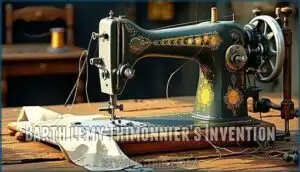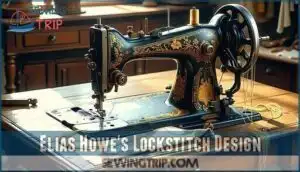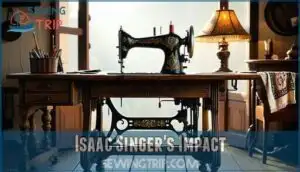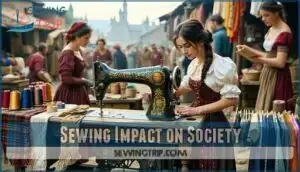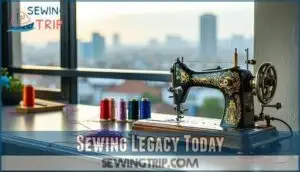This site is supported by our readers. We may earn a commission, at no cost to you, if you purchase through links.
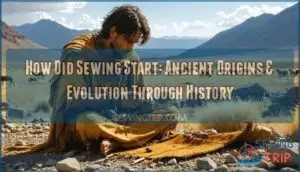
These early humans weren’t just surviving—they were innovating, creating the first needles from bone and using plant fibers to bind materials together.
Archaeological finds show this brilliant solution emerged independently across different continents, proving that necessity really is the mother of invention.
What started as a desperate attempt to stay alive in harsh climates eventually transformed into an art form that would shape entire civilizations and create the foundation for everything from Egyptian burial shrouds to modern haute couture.
Table Of Contents
Key Takeaways
- You’ll discover that sewing began around 20,000 years ago, when early humans used bone needles and animal sinew to stitch hides together for survival
- You can trace how ancient civilizations, like Egypt, Mesopotamia, and China, transformed basic stitching into sophisticated textile arts and embroidery techniques
- You’ll see how the Industrial Revolution’s sewing machines revolutionized garment production, making clothing affordable and accessible to ordinary people
- You’ll find that sewing’s legacy continues today through modern computerized machines, sustainable fashion movements, and its therapeutic benefits as a popular hobby
Sewing Origins Uncovered
You’ll trace sewing’s fascinating journey from humanity’s earliest attempts to join materials together using basic tools and techniques.
Archaeological evidence reveals that our ancestors developed ingenious methods to create clothing and shelter thousands of years ago, setting the foundation for one of civilization’s most essential skills.
Early Sewing Techniques
You’ll discover that early sewing techniques emerged around 17,500 BCE when resourceful humans crafted bone needles with eyes.
These pioneers used animal sinew and natural fibers to stitch hides together, creating essential clothing and shelter.
Ancient sewing methods involved piercing tough materials with bone tools, then threading plant fibers through holes, which led to a needlework revolution that transformed textile origins and sewing history forever.
These garments often utilized tanned animal hides for warmth and durability, showcasing the importance of natural fibers and animal hides in early sewing.
Ancient Civilizations’ Contributions
Ancient civilizations transformed sewing from necessity into art. Egyptian linen production flourished along the Nile, creating elaborate burial textiles and garments. Mesopotamian textiles required incredible skill, with single fabrics needing 22 miles of thread. Chinese silk embroidery became royal luxury during the Han Dynasty.
Aegean garments, however, may have required different sewing methods than those used in Egypt.
- Egyptian Linen: Advanced needlework skills using metal and bone needles from 6000 BCE
- Mesopotamian Textiles: Labor-intensive wool production with standard 13×15 feet fabric sizes
- Ancient Embroidery: Chain, blanket, and satin stitches for decorative and functional purposes
Evolution of Sewing Tools
You’ll find that sewing tools evolved dramatically from primitive beginnings.
Early needles crafted from bone tools gave way to sophisticated metal needles.
Sewing awls helped pierce tough materials while thimble history shows protection became essential.
These sewing innovations transformed needlework origins, ultimately leading to modern sewing machines and revolutionizing the entire sewing evolution process.
The shift to metal needles improved needle durability substantially.
| Tool Type | Material Evolution | Impact on Sewing |
|---|---|---|
| Needles | Bone → Bronze → Steel | Precision stitching possible |
| Thimbles | Leather → Metal → Ceramic | Finger protection enabled |
| Awls | Stone → Iron → Steel | Heavy material piercing |
How Did Sewing Start
Over 20,000 years ago, you’d witness humans creating the first stitches using bone needles and animal sinew. This marked humanity’s breakthrough in transforming raw materials into protective clothing and essential tools.
Twenty thousand years ago, humans first threaded bone needles with sinew, birthing civilization’s most enduring craft.
Ancient civilizations refined these primitive techniques, developing sophisticated methods that laid the groundwork for modern textile production.
Early sewing techniques emerged from necessity:
- Bone needles – Carved from animal bones with eye holes punched through
- Animal sinew threads – Tendons and muscle fibers twisted into strong cordage
- Hide preparation – Leather softened through scraping and natural tanning processes
- Basic stitching patterns – Running stitches and blanket stitches for joining materials
- Tool evolution – Stone awls and bronze needles improved precision and durability
Sewing history reveals how ancient stitches evolved from survival necessity into artistic expression. Fabric origins trace back to plant fibers like flax and cotton, while thread production advanced from twisted animal hair to spun plant materials.
These foundational sewing techniques created the blueprint for all future textile production and fabric crafting innovations. The development of sewing machines relied heavily on understanding the ancient sewing roots to improve their design and functionality.
Sewing Machine History
The textile industry transformed dramatically when inventors created the first mechanical sewing machines in the 1800s. You’ll discover how three key innovators revolutionized garment production and changed manufacturing forever.
Barthélemy Thimonnier’s Invention
French tailor Barthélemy Thimonnier revolutionized textile production in 1830 with his groundbreaking sewing machine patent.
His wooden contraption used a single hooked needle to create chain stitches, mimicking traditional embroidery techniques from his village.
This textile history milestone launched the Industrial Revolution’s impact on garment construction, transforming fabric crafting from hand-sewn methods to mechanized sewing innovations that enhanced sewing skills across France.
The evolution of sewing machines involved key innovations in sewing machine history, which is a crucial part of understanding the Industrial Revolution’s effects on the industry and the development of mechanized sewing.
Elias Howe’s Lockstitch Design
While Thimonnier’s chain-stitch machine sparked initial interest, you’ll find that Elias Howe’s revolutionary lockstitch mechanism truly transformed sewing innovations.
His 1846 patent introduced thread tension control and fabric compatibility that previous machines couldn’t match.
The lockstitch created stronger stitch patterns perfect for garment construction, unlike fragile chain-stitches.
This breakthrough elevated sewing skills and enabled complex fabric art projects that would define embroidery art for generations.
Isaac Singer’s Impact
While Howe perfected the lockstitch mechanism, Singer transformed sewing from craft to industry through his revolutionary business model.
Singer’s innovations didn’t just improve machines—they changed how people accessed and used them entirely.
Singer’s Revolutionary Contributions:
- Installment Payment Plans – Made sewing machines affordable for average households through monthly payments instead of lump-sum purchases
- Mass Production Techniques – Streamlined manufacturing processes that reduced costs and increased availability across markets
- Global Distribution Network – Established worldwide sales offices and service centers, creating the first truly international sewing machine company
- Marketing to Women – Developed advertising campaigns specifically targeting female consumers, recognizing their role in household sewing decisions
Singer’s Industrial Impact created Economic Growth through accessible technology.
His sewing patterns and marketing strategies built modern sewing culture, making handmade clothing production efficient while supporting embroidery art and fashion design development.
Sewing Impact on Society
You’ll discover how sewing transformed from a simple survival skill into a force that revolutionized entire industries and social structures.
The invention of the sewing machine didn’t just speed up garment production—it reshaped how people worked, dressed, and expressed themselves throughout society, which is a complete concept that shows the impact of this invention.
Garment Production Revolution
Manufacturing Systems transformed overnight when sewing machines revolutionized Textile Innovation.
You’d witness factories replacing skilled seamstresses with Industrial Sewing operations, dramatically reducing production costs.
Garment Technology enabled mass production of standardized sewing patterns, making fashion design accessible to ordinary people.
The textile industry shifted from exclusive handmade clothing to affordable ready-to-wear garments, fundamentally changing sewing culture forever.
The sewing machine’s impact on society led to significant changes in industrial labor practices, transforming the way garments were produced and consumed.
Fashion and Style Influence
You’ll find fashion transformed completely once sewing technology advanced beyond basic manufacturing.
The textile industry sparked unprecedented Style Evolution, enabling intricate designs that shaped modern Clothing Culture.
Fashion Icons emerged as skilled seamstresses created elaborate garments previously impossible to produce.
- Runway Trends became accessible to everyday consumers through mass production
- Design Inspiration flourished with complex patterns and decorative elements
- Sewing traditions merged with contemporary fashion, creating lasting clothing styles
Sewing as a Popular Hobby
Beyond traditional garment production, sewing transformed into a beloved hobby that promotes mental wellbeing and emotional resilience.
You’ll discover how fabric choice and sewing patterns became gateways to creative expression and selfcare.
| Aspect | Traditional Focus | Hobby Evolution |
|---|---|---|
| Purpose | Necessity, repairs | Creative expression, relaxation |
| Techniques | Basic hand stitching | Quilting techniques, embroidery designs |
| Community | Family traditions | Clubs, online groups, classes |
Modern sewing traditions emphasize therapeutic benefits, transforming simple hand stitching into mindful practice that enhances emotional wellbeing while preserving cultural heritage.
Sewing Legacy Today
You can trace sewing’s enduring impact from ancient bone needles to today’s computerized machines that stitch with precision your ancestors couldn’t imagine.
Modern sewing technology continues to shape fashion, manufacturing, and creative expression around the world.
Modern Sewing Machines
Modern sewing machines have transformed through technology integration, featuring Sewing Automation that streamlines production.
Machine Learning algorithms optimize stitching patterns while advanced Fabric Cutting systems guarantee precision. Thread Technology improvements deliver stronger, more durable connections.
Contemporary Embroidery Systems create intricate designs automatically. Today’s sewing machines blend traditional craftsmanship with cutting-edge innovation, making complex projects accessible to everyone.
The development of modern sewing is closely related to the use of modern sewing techniques and tools, leveraging Machine Learning and other advancements to enhance the craft.
Sewing Machine Companies
Today’s sewing machine industry reflects decades of innovation from pioneering manufacturers.
Companies like Singer Corporation, Brother Industries, and Janome have transformed how you create garments and crafts.
The development of sewing machines relies on advanced sewing machine technologies.
- Singer Corporation – Founded in 1851, became the world’s largest sewing machine manufacturer by 1860
- Brother Industries – Started in 1908, launched the first computerized sewing machine in 1979
- Janome Machines – Established in 1921, developed early programmable home sewing machines
- Bernina Products – Swiss manufacturer since 1893, specializes in advanced embroidery systems
- Husqvarna Models – Part of SVP Worldwide, known for Viking brand innovations
Enduring Influence on Fashion
Sewing’s revolutionary impact continues shaping fashion identity today.
You’ll witness how textile innovation drives style evolution, from haute couture runways to everyday clothing design.
Fashion trends emerge through skilled seamstresses who transform fabric into wearable art.
This craft offers therapeutic benefits, helping individuals process trauma while creating personal style statements that reflect their unique identity.
| Fashion Era | Key Innovation | Runway Influence |
|---|---|---|
| 1920s | Ready-to-wear | Streamlined silhouettes |
| 1950s | Synthetic fabrics | New textures emerge |
| 1980s | Power dressing | Structured shoulders |
| 2000s | Fast fashion | Trend acceleration |
| 2020s | Sustainable textiles | Eco-conscious designs |
The table highlights key innovations and their impact on fashion trends and runway influence over the decades, showcasing how textile innovation has been a driving force in the evolution of fashion.
Frequently Asked Questions (FAQs)
When did humans start to sew?
Breathtakingly, you’ll thread time back 45,000 years to the Siberian wilderness.
Archaeological evidence shows needles emerged in Eurasia between 45–40 ka BP.
Humans have crafted garments for more than 40,000 years.
Bone needles and animal sinew became humanity’s first tailoring tools, using animal sinew.
Who originally did the sewing?
Women primarily handled sewing in early human societies.
Archaeological evidence shows that you’d find women crafting textiles around 40,000 years ago, passing down techniques through generations and establishing sewing as essential domestic work, which also highlights the importance of women in establishing sewing as essential domestic work.
What is the oldest evidence of sewing?
Threading the historical needle, you’ll find the oldest evidence dates back to the Paleolithic era, around 25,000 years ago.
Stone Age people across Europe and Asia used bone needles and animal sinew to stitch together fur and leather clothing.
The world’s oldest sewing needle was discovered in Siberia’s Denisova Cave, which is a significant archaeological find.
Who invented thread for sewing?
You can’t pinpoint one inventor since ancient peoples created thread from natural fibers like plant stems and animal sinew.
Archaeological evidence shows early humans twisted fibers together thousands of years ago, developing this essential tool through collective innovation rather than individual invention.
What materials were used before needles existed?
Before needles existed, you’d have used sharp bones, thorns, and pointed sticks to pierce materials.
Early humans fashioned awls from animal bones and antlers to create holes for threading sinew or plant fibers through leather and fabric, which is a complete concept of using available resources to create tools.
Which culture invented the first sewing techniques?
You’ll find that early humans across multiple cultures developed sewing techniques independently.
Archaeological evidence shows the earliest known sewing appeared around 40,000 years ago in various regions simultaneously, making it impossible to credit one specific culture with the invention.
How did people learn sewing skills historically?
You’d learn sewing through family apprenticeships, watching skilled seamstresses in your community, and practicing basic stitches on scraps.
Guild systems formalized training, while necessity drove innovation through trial and error across generations, with guild systems being a key part of this process.
What role did sewing play in trade?
You’d find sewing became essential for trade routes as merchants needed skilled seamstresses to create, repair, and customize textiles for different markets, currencies, and cultural preferences across civilizations.
When did decorative sewing techniques first appear?
You’ll notice decorative sewing took off around 30,000 years ago when Russian Cro-Magnon hunter’s clothes, boots, and hat were heavily decorated with handmade embroidery and ivory beads.
Ancient civilizations turned utility into art.
Conclusion
From survival necessity to artistic mastery, understanding how did sewing start reveals humanity’s remarkable journey from survival to self-expression.
What began as crude animal hide piercing with bone needles evolved into sophisticated techniques that built civilizations and created entire industries.
You’ve witnessed how ancient innovations shaped modern fashion, transformed economies, and turned practical skills into beloved hobbies.
Today’s computerized machines still echo those first stitches our ancestors made 20,000 years ago, proving that human ingenuity never goes out of style, and is a testament to humanity’s ability to adapt and evolve.
- https://historyofinformation.com/detail.php?entryid=4063
- https://www.awilson.co.uk/sewing-for-survival-how-sewing-caused-the-survival-of-the-human-race/
- https://hotpinkhaberdashery.com/blogs/news/the-history-of-sewing
- https://blogs.duanemorris.com/fashionretailbrandedconsumergoods/2023/03/30/an-eye-for-an-eye-a-very-brief-history-of-the-sewing-needle/
- https://millmuseum.org/history-2/din-of-machines/sewing-revolution/

